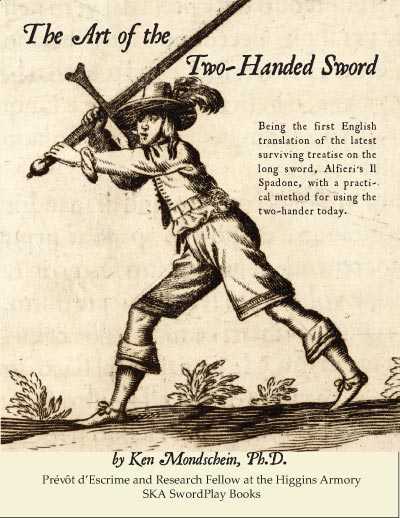
Alfieri's Spadone
Click on the cover to buy Ken's translation of Francesco Alfieri's treatise on the two-handed sword, with a modern pedagogical guide for historical fencers, or scroll down to read about it.
"Ken Mondschein brings to practitioners of both modern and ancient fencing systems a clear and concise translation of an important but often-overlooked work, Francesco Alfieri’s Lo Spadone, along with relevant sections from Giuseppe Colombani, Giacomo di Grassi, Camillo Agrippa, and from a manuscript known as the Anonimo Riccardiano. Together these works give us a clear picture of the spadone, a weapon and fencing style of the Renaissance that was in its day as important as the better-known rapier... It is through well-conceived and well-executed works such as this one that ancient fencing continues to live, and to speak to new audiences. "
—Maestro Sean Hayes
Corrections and Emendations:
p. 44: Read "finish" for "feint"; I misread "finti" for "finiti."
p 65: "and never give a thrust unless he seems rather weak."
p. 89, Section 1.4.1: Games that build fencing skills such as distance, timing, differential reaction, etc., are best of all.
p. 89, Section 2.3: There are other correctives possible for people who hit with excessive force, such as purposely-designed partner drills.
p. 105, Section 3.3.9, line 2: Obviously, "Parries" rather than "P' arries." The typesetter introduced this error and then did not change it.
p. 114, Section 3.8: The photos show the point ascending in parries 5 and 6, whereas elsewhere I say to parry with the point sloping down; the photos, of course, show the "classical" parries from sabre.
! I would also like to make a significant note here: After several broken and brusied fingers, in lieu of (or in addition to) the parries in fifth and sixth, I am now making them in a sort of high guard (Fiore's posta di finestra) with the point more forwards and the hands pulled back and raised over the head.
p. 199, third paragraph, sixth sentence: The "moulinet" should say "molinello," of course.
p. 125, Section 4.4.2: "It is easiest to align the true edge with forehand cuts, and the false edge with reverse cuts, as Grassi and other sources advise... This exercise is essentially the 'thwart' cut, if it is made with the compass step (Section 5.8)." Of course, most German sources (Meyer, for instance) say to make a forehand thwart (zwerchau) with the back edge while placing the thumb on the flat of the blade, while the reverse is made with the true edge. Italian and Spanish sources are frustratingly unclear: Alfieri is silent; Fiore and Vadi say, in general, to cut reverses with the false edge, and this is my interpretation of Figueiredo and Grassi (see p. 72). It also feels more natural with a long, heavy sword. (Thanks to Emil Andersson for bringing this up.)
I personally don't think it matters which edge is used, so long as it is done effectively; my own practice is to do both forehand and backhand thwarts with the true edge—which obviously contradicts the sources, but which feels more natural in light of how I was trained and the fact that I often get my thumb hit rather painfully when putting it on the flat of the blade.
There is also some repetition in the paragraph.
p. 168, Section 8.1: The very last line on page should read "Fencer B." (Thanks to Chris Palagi for catching this.)
p. 190, Section 11.2.2: The croisé is the German mutieren. (Thanks to Steven Hirsch for pointing this out.)
p. 110, Section 3.6.1: Fiore, of course, mentions the via, or line of direction.
p. 141, Photo 5.6.1–1: The footprint for my right foot should be at an angle, along what will be the new line of direction.
p. 151, Section 6.1.3: The "star" drill is actually found in Meyer, though I developed it from an escrima drill several years before I discovered Meyer's work through Jeffrey Forgeng's translation.
p. 170, Section 8.3: In the circle drills, the forward foot should match the direction you are cutting from, i.e., the right foot if cutting from the right. Obviously, these are indirect ripostes, since the molinello changes lines. (Also, the first "thus" before the list is the wrong font size.)
p. 176, Section 8.6, third item in the bulleted list: Fencer A should drop his point to seventh, not first. (Thanks to Chris Palagi for catching that.)